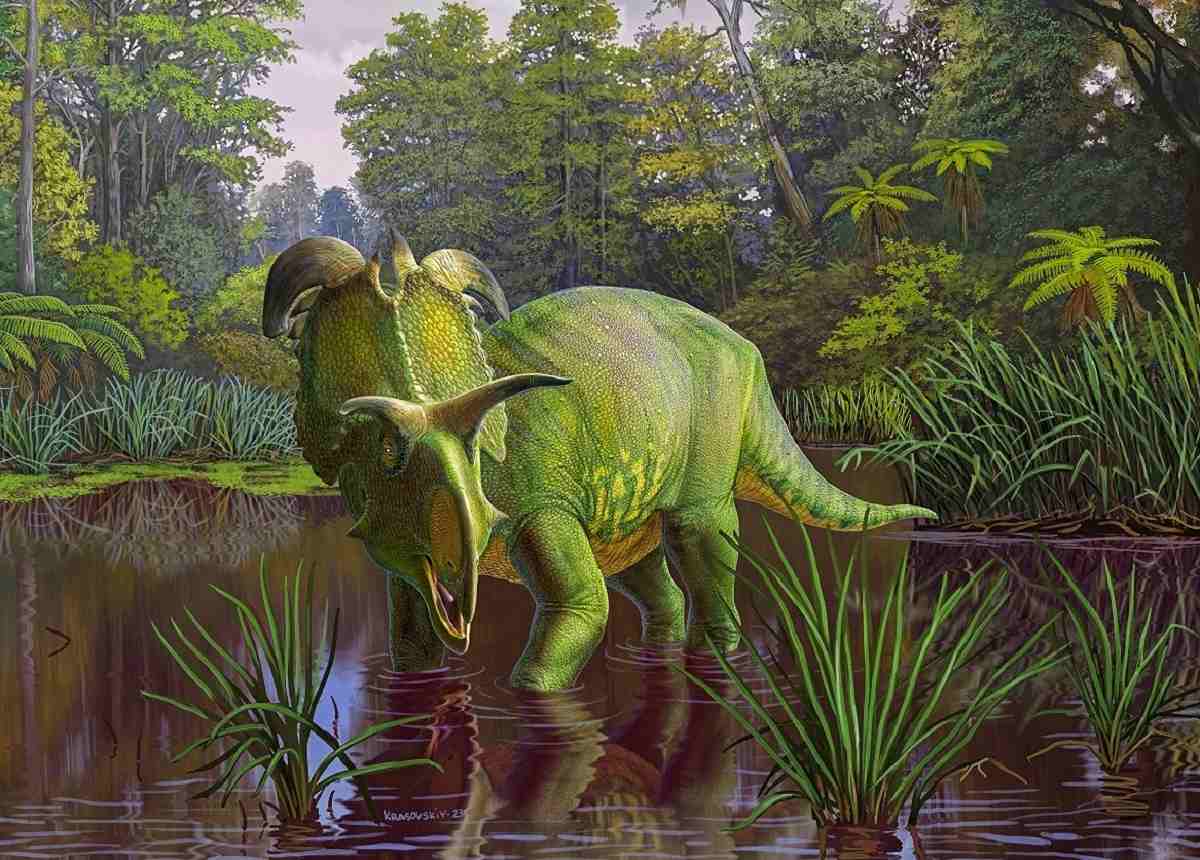
An artist’s impression of Cretaceous Period horned dinosaur Lokiceratops is seen in this image.
17:34 JST, July 11, 2024
WASHINGTON (Reuters) — About 78 million years ago in what was then a subtropical coastal plain — now the badlands of northern Montana — lived a four-legged plant-eating dinosaur built a bit like a rhinoceros with a fabulously ornate set of horns on its head.
This newly identified dinosaur, called Lokiceratops rangiformis, was about 6.7 meters long, weighed around 5½ tons and used a powerful beak at the front of its mouth to browse on low-growing vegetation such as ferns and flowering plants, scientists said on June 20.
Lokiceratops had two curving horns more than 40 centimeters long above its eyes, small horns on its cheeks, and blades and spikes along its extended head shield. On this frill, it had at least 20 horns including an asymmetrical pair of curved blade-shaped ones, each about 61 centimeters long. Those are the largest frill horns ever observed on a dinosaur.
These blade-like horns, evocative of weaponry wielded by the trickster god Loki in Norse mythology, helped inspire its scientific name, which also recognizes the permanent home of the fossils at the Museum of Evolution in Denmark. The name means “Loki’s horned face” and “formed like a caribou,” referring to the fact that its frill displays horns of different lengths on each side, like caribou antlers.
It was one of numerous species of horned dinosaurs, called ceratopsians, that roamed western North America during the Cretaceous Period at a time when a large inland sea split the continent in half.
Lokiceratops pushes the envelope on bizarre headgear for ceratopsians, according to paleontologist Joe Sertich of the Smithsonian Tropical Research Institute and Colorado State University, co-lead author of the study published in the journal PeerJ.
“The horns and frill were most likely used for display in Lokiceratops and other horned dinosaurs. These displays could have been used to intimidate rivals, attract mates or recognize members of the same species,” Sertich said.
The lack of a nose horn, present in many ceratopsians, lessens the likelihood that Lokiceratops used its horns to defend against predators, according to paleontologist and study co-lead author Mark Loewen of the University of Utah and the Natural History Museum of Utah.
The Lokiceratops fossils were unearthed at a Montana site about 3.6 kilometers south of the U.S. border with Canada. Lokiceratops inhabited a coastal plain featuring forests, lakes and swamps along the eastern coast of Laramidia, the landmass that comprised western North America.
The ceratopsian family tree has two main groups: chasmosaurines, including the largest of the horned dinosaurs Torosaurus and Triceratops, and centrosaurines, like Lokiceratops.
Dinosaurs in these two groups may have fed differently, minimizing their competition for resources. Ceratopsian dinosaurs had mouths containing more than 200 teeth that could shear vegetation.
Surprisingly, Lokiceratops was one of five horned dinosaur species sharing the same ecosystem. Four of them were centrosaurines, including two close relatives of Lokiceratops in Medusaceratops and Albertaceratops.
“Really, this is like finding five species of elephants living on the same savanna in Kenya,” Loewen said.
The presence of all of these animals together indicates there was a rapid evolution of new centrosaurine species occurring in a limited geographical region, Sertich said.
Other dinosaurs in this ecosystem included the herbivorous duckbilled dinosaur Probrachylophosaurus and a large carnivorous dinosaur, known only from tooth fossils and not yet given a name, from the same lineage as the later T-Rex. Lokiceratops was the most massive plant-eater in the ecosystem.
“This is the first time five ceratopsians have been recognized from the same ecosystem. For over a century, it was believed that no more than two could coexist in the same ecosystem, but emerging evidence here in Montana, and elsewhere in southern Laramidia, is revealing unexpected richness,” Sertich said.
“This parallels a pattern seen in mammalian evolution that is still on display in east and south Africa with bovids —antelope and buffalo,” Sertich added.
Related Tags
"Science & Nature" POPULAR ARTICLE
-

Genome Study Reveals Milestone in History of Cat Domestication
-

Big Leap in Quest to Get to Bottom of Climate Ice Mystery
-

Japan Set to Participate in EU’s R&D Framework, Aims to Boost Cooperation in Tech, Energy
-

Paws on Parade: Nairobi’s Dogs Dazzle at ‘Pawchella’
-

Japan’s H3 Rocket Failed in Latest Launch, Says Official
JN ACCESS RANKING
-

Tokyo Economic Security Forum to Hold Inaugural Meeting Amid Tense Global Environment
-

Keidanren Chairman Yoshinobu Tsutsui Visits Kashiwazaki-Kariwa Nuclear Power Plant; Inspects New Emergency Safety System
-

Imports of Rare Earths from China Facing Delays, May Be Caused by Deterioration of Japan-China Relations
-

University of Tokyo Professor Discusses Japanese Economic Security in Interview Ahead of Forum
-

Japan Pulls out of Vietnam Nuclear Project, Complicating Hanoi’s Power Plans






















